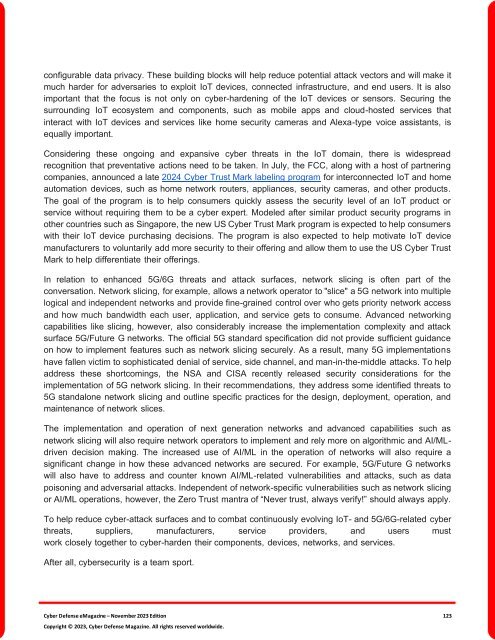The Cyber Defense eMagazine November Edition for 2023
Cyber Defense eMagazine November Edition for 2023 #CDM #CYBERDEFENSEMAG @CyberDefenseMag by @Miliefsky a world-renowned cyber security expert and the Publisher of Cyber Defense Magazine as part of the Cyber Defense Media Group as well as Yan Ross, Editor-in-Chief and many more writers, partners and supporters who make this an awesome publication! 196 page November Edition fully packed with some of our best content. Thank you all and to our readers! OSINT ROCKS! #CDM #CDMG #OSINT #CYBERSECURITY #INFOSEC #BEST #PRACTICES #TIPS #TECHNIQUES
Cyber Defense eMagazine November Edition for 2023 #CDM #CYBERDEFENSEMAG @CyberDefenseMag by @Miliefsky a world-renowned cyber security expert and the Publisher of Cyber Defense Magazine as part of the Cyber Defense Media Group as well as Yan Ross, Editor-in-Chief and many more writers, partners and supporters who make this an awesome publication! 196 page November Edition fully packed with some of our best content. Thank you all and to our readers! OSINT ROCKS! #CDM #CDMG #OSINT #CYBERSECURITY #INFOSEC #BEST #PRACTICES #TIPS #TECHNIQUES
You also want an ePaper? Increase the reach of your titles
YUMPU automatically turns print PDFs into web optimized ePapers that Google loves.
configurable data privacy. <strong>The</strong>se building blocks will help reduce potential attack vectors and will make it<br />
much harder <strong>for</strong> adversaries to exploit IoT devices, connected infrastructure, and end users. It is also<br />
important that the focus is not only on cyber-hardening of the IoT devices or sensors. Securing the<br />
surrounding IoT ecosystem and components, such as mobile apps and cloud-hosted services that<br />
interact with IoT devices and services like home security cameras and Alexa-type voice assistants, is<br />
equally important.<br />
Considering these ongoing and expansive cyber threats in the IoT domain, there is widespread<br />
recognition that preventative actions need to be taken. In July, the FCC, along with a host of partnering<br />
companies, announced a late 2024 <strong>Cyber</strong> Trust Mark labeling program <strong>for</strong> interconnected IoT and home<br />
automation devices, such as home network routers, appliances, security cameras, and other products.<br />
<strong>The</strong> goal of the program is to help consumers quickly assess the security level of an IoT product or<br />
service without requiring them to be a cyber expert. Modeled after similar product security programs in<br />
other countries such as Singapore, the new US <strong>Cyber</strong> Trust Mark program is expected to help consumers<br />
with their IoT device purchasing decisions. <strong>The</strong> program is also expected to help motivate IoT device<br />
manufacturers to voluntarily add more security to their offering and allow them to use the US <strong>Cyber</strong> Trust<br />
Mark to help differentiate their offerings.<br />
In relation to enhanced 5G/6G threats and attack surfaces, network slicing is often part of the<br />
conversation. Network slicing, <strong>for</strong> example, allows a network operator to "slice" a 5G network into multiple<br />
logical and independent networks and provide fine-grained control over who gets priority network access<br />
and how much bandwidth each user, application, and service gets to consume. Advanced networking<br />
capabilities like slicing, however, also considerably increase the implementation complexity and attack<br />
surface 5G/Future G networks. <strong>The</strong> official 5G standard specification did not provide sufficient guidance<br />
on how to implement features such as network slicing securely. As a result, many 5G implementations<br />
have fallen victim to sophisticated denial of service, side channel, and man-in-the-middle attacks. To help<br />
address these shortcomings, the NSA and CISA recently released security considerations <strong>for</strong> the<br />
implementation of 5G network slicing. In their recommendations, they address some identified threats to<br />
5G standalone network slicing and outline specific practices <strong>for</strong> the design, deployment, operation, and<br />
maintenance of network slices.<br />
<strong>The</strong> implementation and operation of next generation networks and advanced capabilities such as<br />
network slicing will also require network operators to implement and rely more on algorithmic and AI/MLdriven<br />
decision making. <strong>The</strong> increased use of AI/ML in the operation of networks will also require a<br />
significant change in how these advanced networks are secured. For example, 5G/Future G networks<br />
will also have to address and counter known AI/ML-related vulnerabilities and attacks, such as data<br />
poisoning and adversarial attacks. Independent of network-specific vulnerabilities such as network slicing<br />
or AI/ML operations, however, the Zero Trust mantra of “Never trust, always verify!” should always apply.<br />
To help reduce cyber-attack surfaces and to combat continuously evolving IoT- and 5G/6G-related cyber<br />
threats, suppliers, manufacturers, service providers, and users must<br />
work closely together to cyber-harden their components, devices, networks, and services.<br />
After all, cybersecurity is a team sport.<br />
<strong>Cyber</strong> <strong>Defense</strong> <strong>eMagazine</strong> – <strong>November</strong> <strong>2023</strong> <strong>Edition</strong> 123<br />
Copyright © <strong>2023</strong>, <strong>Cyber</strong> <strong>Defense</strong> Magazine. All rights reserved worldwide.

















